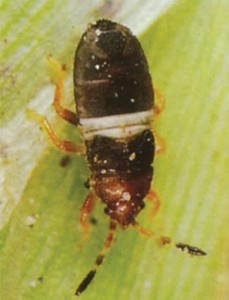New Tree Do’s and Don’ts!
- Do plant the tree at the right depth, with the top of the root ball as high or slightly higher than surrounding soil.
- Do eliminate competition from lawn by clearing the grass out a minimum of 18″ (more is better) from the trunk and keeping the cleared area mulched.
- Don’t “volcano mulch” the trunk of your new tree, 2″ of mulch over the roots and 1″ or less touching the trunk.
- Don’t let a string trimmer get close enough to strip off the bark of your new tree.
- Don’t use “weed-and-feed” fertilizer near your new tree.
- Don’t excessively prune all lower growth off your new tree thinking it will make your tree grow up faster; it will actually slow growth of roots, trunk diameter, and height.
- Do check watering frequently through the first summer and water as
needed.
Spring Insect Explosion
With the warm wet days of spring, the insect population explodes. Mother Nature multiplies at an amazing rate. Aphids, scale, thrips, and caterpillars of every size and shape have appeared. Do not hesitate to prevent these insects now.
We talked a couple of weeks ago about using the Bayer Tree and Shrub Protect and Feed as a drench to prevent the big spring bug invasion. Well, it is upon us, but still not too late to treat. We have plenty in stock, so come see us soon.
We are also hearing a lot about snails, slugs, pill bugs and cutworms out in enormous numbers. As soon as we plant our pretty spring flowers these bugs look at it as their own breakfast buffet. A safe and effective organic treatment is Monterey Sluggo Plus. Safe to use around vegetables, fruit trees, citrus, berries, flowers, ornamentals and all landscape plants. 1 lb. treats 2000 sq. ft. and lasts up to 4 weeks. Evening is the best time to apply the bait as pest travel and feed mostly by night or early morning.

“A month ago, I installed a “Livin’ Easy” Rose in one of my front beds. It started out at about 18″ tall. Now, its 4 feet tall and full of bright orange 4 inch blooms which smell wonderful! The “Livin’ Easy” Rose is very “gardener friendly”, even for beginners. I look forward to many years of this wonderful Floribunda’s show. For roses and for other flowering plants, I recommend Maestro Rose Glo as a great source of nutrition to keep ’em blooming and looking their best!”
 My mother, Ruth Gill, was a quirky but elegant, courageous yet tender, intelligent and curious woman. And I can put that in this blog because its Mother’s Day! But back to gardening, with just a few of her quirky twists.
My mother, Ruth Gill, was a quirky but elegant, courageous yet tender, intelligent and curious woman. And I can put that in this blog because its Mother’s Day! But back to gardening, with just a few of her quirky twists. that most people miss. I am so thankful to my mother for opening my eyes to the wonders of nature and gardening.
that most people miss. I am so thankful to my mother for opening my eyes to the wonders of nature and gardening.  Time to treat for grub worms. Did you know, grub worms come from June bugs? Grubs are the larval stage of the brown June Beetle that flies around your porch light every Spring. If you notice a large number of these beetles, you may want to consider treating your yard with Bayer Season Long Grub Control. It works to kill grubs for approx. 3 months. Grub worms eat the roots of your grass during the early spring and summer causing the area to die. You can literally roll your lawn up like a carpet. If you have grubs each year, then it is likely you will have them again. Taking precaution now is better than waiting till late summer or early fall and seeing the damage already done. An organic solution is to spray out Beneficial Nematodes. Each sponge contains 5 million nematodes, enough to treat 2000 sq. ft. of surface area. Reapplying these nematodes monthly will help to build the population for effective control of grubs and fleas through the summer. If do not want to treat or are unsure if you have the problem, just watch your grass closely. Any areas that look dry and wilted but the rest of yard does not, it could be grubs. Dig down and look. If you find more than 4 grubs in one square foot of area, then you should treat with Bayer 24 hour. If no grubs are found, and
Time to treat for grub worms. Did you know, grub worms come from June bugs? Grubs are the larval stage of the brown June Beetle that flies around your porch light every Spring. If you notice a large number of these beetles, you may want to consider treating your yard with Bayer Season Long Grub Control. It works to kill grubs for approx. 3 months. Grub worms eat the roots of your grass during the early spring and summer causing the area to die. You can literally roll your lawn up like a carpet. If you have grubs each year, then it is likely you will have them again. Taking precaution now is better than waiting till late summer or early fall and seeing the damage already done. An organic solution is to spray out Beneficial Nematodes. Each sponge contains 5 million nematodes, enough to treat 2000 sq. ft. of surface area. Reapplying these nematodes monthly will help to build the population for effective control of grubs and fleas through the summer. If do not want to treat or are unsure if you have the problem, just watch your grass closely. Any areas that look dry and wilted but the rest of yard does not, it could be grubs. Dig down and look. If you find more than 4 grubs in one square foot of area, then you should treat with Bayer 24 hour. If no grubs are found, and  the ground is hard and dry, then check your sprinkler to make sure it is watering that area as evenly as the rest of the lawn.
the ground is hard and dry, then check your sprinkler to make sure it is watering that area as evenly as the rest of the lawn. Every year around this time, I think about how much my Mom has done for me. When I drive back home to visit her, I always look for her favorite flower (which of course is a weed!). Much to my Dad’s chagrin, I arrive home with a bushel full of Queen Anne’s Lace. If I could, I’d buy her enough Queen Anne’s Lace to make a whole bed of it for her, but generally nurseries don’t sell too many weeds! For Mother’s Day this year, instead of buying your Mom cut flowers, why not find out her favorite
Every year around this time, I think about how much my Mom has done for me. When I drive back home to visit her, I always look for her favorite flower (which of course is a weed!). Much to my Dad’s chagrin, I arrive home with a bushel full of Queen Anne’s Lace. If I could, I’d buy her enough Queen Anne’s Lace to make a whole bed of it for her, but generally nurseries don’t sell too many weeds! For Mother’s Day this year, instead of buying your Mom cut flowers, why not find out her favorite  flower and come to Gill’s. We’ll help you take that flower and make a gift that lasts not just a few weeks, but for years.
flower and come to Gill’s. We’ll help you take that flower and make a gift that lasts not just a few weeks, but for years. Seems a little early with all the rain, but the temperatures are right on up there where they should be for May. I am seeing lots of damage to the lawns and finding chinch bugs. Areas of the lawn will look dry, especially near the sidewalk or driveway where it is the hottest. If you dig up a shovel width piece of lawn and shake it over white paper, you will see small black bugs with a white stripe across their back. The old method was to cut the bottom out of a coffee can and push it into the soil of the dry area, fill it with water and the chinch bugs would float. Try finding a metal coffee can these days! You can spray the areas with Cyonara,
Seems a little early with all the rain, but the temperatures are right on up there where they should be for May. I am seeing lots of damage to the lawns and finding chinch bugs. Areas of the lawn will look dry, especially near the sidewalk or driveway where it is the hottest. If you dig up a shovel width piece of lawn and shake it over white paper, you will see small black bugs with a white stripe across their back. The old method was to cut the bottom out of a coffee can and push it into the soil of the dry area, fill it with water and the chinch bugs would float. Try finding a metal coffee can these days! You can spray the areas with Cyonara,  stay away from them until the days get longer and drier. With rain and heavy moisture in the air, they suffer from Phytophthora, an airborne fungus, and die within days. We promise we will get them in as soon as conditions permit!!
stay away from them until the days get longer and drier. With rain and heavy moisture in the air, they suffer from Phytophthora, an airborne fungus, and die within days. We promise we will get them in as soon as conditions permit!! opposed to toxic chemicals, it makes the soil healthier with every application. It also stops the development of the nodes or nutlets underground.
opposed to toxic chemicals, it makes the soil healthier with every application. It also stops the development of the nodes or nutlets underground.  This video from Texas A&M on the Cycle Soak Method
This video from Texas A&M on the Cycle Soak Method
